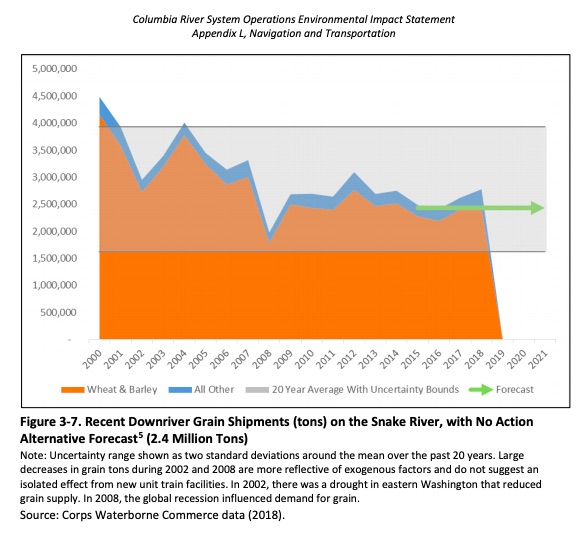forum
library
tutorial
contact

National, Regional Ag Leaders get Close-up Look
at Lower Snake River Dam Issues
by Matthew Weaver
Bend Bulletin, June 20, 2021
|
the film forum library tutorial contact |

|
National, Regional Ag Leaders get Close-up Look
by Matthew Weaver
|
Farmers shouldn't let their guard down when it comes to Rep. Mike Simpson's call
to breach the four Lower Snake River dams in the name of salmon recovery
 LEWISTON, Idaho -- Leaders of national and regional farm organizations rallied around efforts to protect the four lower Snake River dams last week, taking part in a day-long briefing on the role the structures play in the Pacific Northwest economy.
LEWISTON, Idaho -- Leaders of national and regional farm organizations rallied around efforts to protect the four lower Snake River dams last week, taking part in a day-long briefing on the role the structures play in the Pacific Northwest economy.
Among those joining the group were Zippy Duvall, president of the American Farm Bureau Federation -- the nation's largest agricultural organization -- and Chandler Goule, CEO of the National Association of Wheat Growers.
Farmers shouldn't let their guard down when it comes to Rep. Mike Simpson's call to breach the Snake River dams in the name of salmon recovery, Goule warned.
Simpson's $33.5 billion concept calls for breaching the four lower Snake River dams and mitigating affected communities and industries.
The idea is gaining momentum in Congress heading into the mid-term elections, Goule said.
Simpson, a member of the House Appropriations Committee, has not proposed any legislation, but he will work to insert the money into an appropriations bill without instructions to breach the dams, Goule said.
"If that money gets appropriated, then that gets him a much stronger hand to come back and actually get the dams torn down," Goule said.
Simpson used a similar tactic on another issue 10 years ago, Goule said.
"He already knows politically that strategy is going to work," Goule said.
It would likely be in next year's appropriations, Goule said. The bill would have to go through the House and Senate, and the president would have to sign it.
Duvall, Goule and 43 others representing ag organizations, co-ops and related businesses were hosted by the Idaho Grain Producers Association and the Idaho Farm Bureau.
Tour participants took a boat through a navigation lock and toured the dam complex, seeing fish ladders and juvenile and adult fish, and toured the Lewis-Clark Terminal, owned by CHS Primeland, the Pacific Northwest Farmers Co-op and Uniontown Co-op.
 Agricultural advocates say breaching the dams isn't the "silver bullet" for salmon recovery that environmentalists claim, noting that mortality rates on the Snake River are similar for salmon elsewhere on the West Coast.
Agricultural advocates say breaching the dams isn't the "silver bullet" for salmon recovery that environmentalists claim, noting that mortality rates on the Snake River are similar for salmon elsewhere on the West Coast.
"I didn't see today the problems that (Simpson) described. ... I didn't see the science that supported that," said Duvall, of the American Farm Bureau Federation.
Duvall compared Simpson to a doctor who calls for a heart transplant when some medicine will do.
"If we think about the $34 billion and just take a portion of it, put it in research and development of the other problems that might be facing the salmon, we can fix that problem with a little medicine rather than transplanting a heart," Duvall said.
Breaching the dams would make the lower Snake River "completely unnavigable," and require adding 38,000 more rail cars or 150,000 more trucks to replace barges, Goule said.
About 60% of Washington's and Idaho's wheat is shipped by barge, according to the Lewis-Clark Terminal. It takes 5 1/2 hours to load one 3,600-ton barge, the equivalent of 120 truckloads of wheat.
A proposed transportation credit or subsidy under Simpson's plan could also potentially be out of compliance with World Trade Organization regulations, Goule said, adding that it could be considered trade-distorting, undercutting export competition.
The dams are critical for the West Coast's export and import markets, said Jeff Van Pevenage, president and CEO of Columbia Grain International in Portland.
Some 60-65% of the wheat exported using the Columbia-Snake River system originates in the Lower Snake River region, consisting of 13 barge facilities with more than 10 owners, Van Pevenage said.
"Without the current volume, you will endanger the economic viability of at least two of the export facilities that exist in Portland," Van Pevenage said. Those facilities rely heavily on barges and don't have the ability to expand rail capacity, he said.
Barging provides transportation competition and alternatives to keep freight rates in check, Van Pevenage said. Without it, rail costs for grain shipments to Portland could potentially more than double, particularly during the fall, when corn and soybean shipments from the Midwest are also heavy.
Without barging, many regional farmers could find themselves in a "captive shipping" scenario, similar to one experienced today by Montana farmers, Van Pevenage said.
"As an example, at times today, you can ship wheat from eastern North Dakota through Montana to the West Coast for cheaper rates than you can ship from Montana to the PNW," he said. "It's very possible those types of scenarios will exist here without the competition."
learn more on topics covered in the film
see the video
read the script
learn the songs
discussion forum
